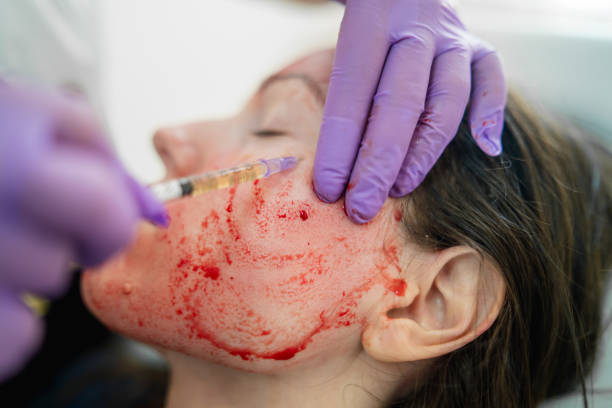The appearance of your face after microneedling can vary depending on the intensity of the treatment and your skin type. Generally, you can expect the following timeline:
- Immediately After Treatment:
- Your face will likely be red and may look sunburned. This redness can last from a few hours to a couple of days.
- You might experience some swelling and minor pinpoint bleeding.
- 1-3 Days Post-Treatment:
- Redness and swelling typically subside within this period.
- Your skin might feel tight, dry, and sensitive.
- Some people experience mild peeling or flaking.
- 3-5 Days Post-Treatment:
- Redness should significantly diminish, though you might still notice some pinkness.
- Any minor bruising or swelling should continue to improve.
- Skin might still be dry and flaky.
- 1 Week Post-Treatment:
- Most visible side effects should be gone.
- Your skin may still feel slightly sensitive, but overall, it should look and feel much better.
- 2 Weeks and Beyond:
- Your skin should be fully healed.
- You may begin to see some of the positive effects of microneedling, such as improved texture and tone.
It’s important to follow post-treatment care instructions provided by your practitioner, which may include avoiding direct sunlight, not using certain skincare products, and keeping your skin hydrated. Everyone’s skin heals differently, so some people might recover faster or slower than others. If you have any concerns about your recovery process, it’s best to consult with your dermatologist or skincare professional.

What happens if you microneedle too much?
Microneedling too frequently or too aggressively can lead to several negative side effects and potential skin damage. Here are some possible consequences of overdoing microneedling:
- Skin Irritation and Inflammation:
- Over-microneedling can cause prolonged redness, swelling, and irritation.
- It can lead to inflammation, making the skin more sensitive and reactive.
- Barrier Damage:
- The skin’s natural barrier may become compromised, leading to increased dryness, flakiness, and a higher risk of infection.
- This can result in chronic irritation and difficulty retaining moisture.
- Hyperpigmentation:
- Repeated trauma to the skin can lead to post-inflammatory hyperpigmentation, where areas of the skin become darker than the surrounding skin.
- Scarring:
- Instead of promoting healing, excessive microneedling can cause micro-tears and actual scarring, especially if the needles are too long or the treatment is done improperly.
- Delayed Healing:
- Skin needs time to repair and regenerate between treatments. Microneedling too often can disrupt this process, leading to delayed healing and potentially worsening the skin’s condition.
- Increased Sensitivity:
- Your skin can become overly sensitive, making it more susceptible to environmental damage and less tolerant to skincare products.
- Infection:
- Repeated puncturing without adequate healing time can increase the risk of infection, particularly if proper sterilization and hygiene practices are not followed.
Recommended Frequency
- Home Microneedling: Devices with shorter needles (0.25mm to 0.5mm) can be used more frequently, typically every 1-2 weeks, depending on your skin’s response.
- Professional Microneedling: Treatments with longer needles (0.5mm to 2.5mm) should be spaced out more, usually every 4-6 weeks, to allow the skin adequate time to heal and regenerate.
Tips for Safe Microneedling
- Consult a Professional: Always seek advice from a dermatologist or skincare professional to determine the appropriate needle length and treatment frequency for your skin type and concerns.
- Follow Post-Treatment Care: Adhere to post-treatment instructions, including using gentle skincare products, avoiding sun exposure, and keeping the skin hydrated.
- Monitor Your Skin: Pay attention to how your skin reacts and adjust the frequency of treatments accordingly. If you notice persistent redness, irritation, or other adverse effects, give your skin a longer break between sessions.
By following these guidelines, you can minimize the risks and maximize the benefits of microneedling.
